Day 1 of a long weekend of tours today. It was a glorious sunny day, some hazy cloud in the morning and a nice cooling easterly breeze on the coast in the afternoon. We met in Wells and headed west today.
Our first stop was at Choseley. The Dotterel which have been in the fields here for the last few days had not been reported yet this morning, but when we arrived there were several people watching them. They seemed unconcerned by the tractor spraying the field. They were feeding in a strip at the back of the field which had more dried weedy stems, which made them extra difficult to see at times. However, eventually we all got good views of them through the scope.
 Dotterel – here are a couple for a few days ago
Dotterel – here are a couple for a few days ago
When we had finished watching the Dotterel, we turned out attention to the surrounding farmland. There were lots of Brown Hares in the fields, chasing each other round in circles, but not boxing today. A Marsh Harrier was quartering one of the fields and managed to flush a couple of Red-legged Partridge out from the winter wheat.
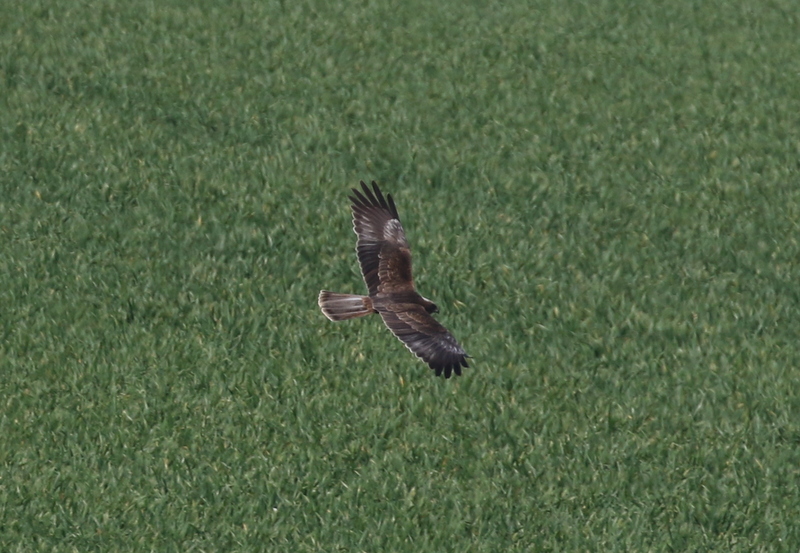 Marsh Harrier – quartering the fields at Choseley
Marsh Harrier – quartering the fields at Choseley
We could hear a Corn Bunting singing behind us and when we turned round we found it perched in the top of the hedge. It flew round the field several times, singing from a high vantage point each time wherever it landed.
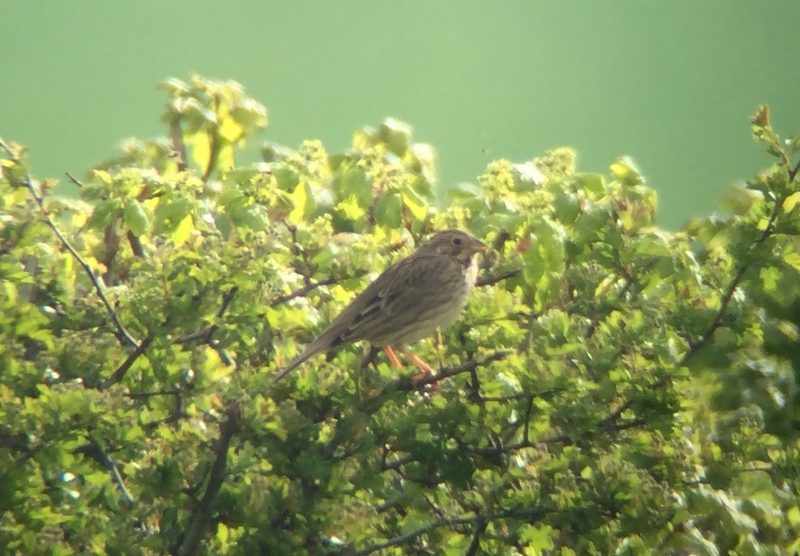 Corn Bunting – singing from the top of the hedges
Corn Bunting – singing from the top of the hedges
Our next destination was at Snettisham. As we walked up through the Coastal Park, lots of warblers were singing from the trees, bushes and reeds. We could hear lots of Sedge Warblers, one or two Reed Warblers and the odd Cetti’s Warbler, lots of Common Whitethroats plus one or two Lesser Whitethroats and several Blackcaps, and both Chiffchaff and Willow Warbler.
It was only when we got further in that we heard our first Grasshopper Warbler. We followed the strange, rather cricket-like reeling sound, but discovered it had tucked itself away in a rather inaccessible area. A second Grasshopper Warbler then started up, reeling quite close by. Unfortunately, that one went quiet before we could get over to it. It seemed like we might struggle to see a Grasshopper Warbler until we heard our third reeling bird of the morning. This one was in a more open area, but still took some tracking down. It was singing initially from low down in the bushes and only when it worked its way higher up could we get it in the scope and get a good look at it. It tried to keep itself well hidden in a hawthorn, but by carefully positioning the scope we could see all the requisite details.
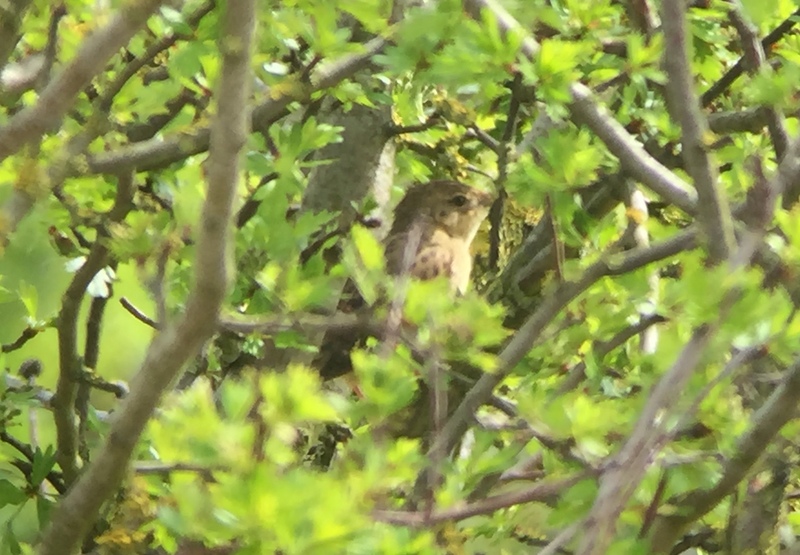 Grasshopper Warbler – 1 of 3 reeling today
Grasshopper Warbler – 1 of 3 reeling today
We had not seen many obviously new migrants this morning and, unlike in recent days, there was no obvious visible migration overhead. However, while we were tracking down the third Grasshopper Warbler, our attention was drawn to a bird which flicked out of the trees beyond. It was a Spotted Flycatcher. Though they breed in the UK, there are increasingly scarce in Norfolk and this one was clearly a migrant which had stopped off on its way north. Which watched it make a couple of sallies out from the branches, after insects, before a male Blackcap chased it off.
We had a quick look out at the Wash. The tide was well out now and it was a bit hazy. However, out in the distance we could see a huge slick across the mud. Through the scope, we could see there were thousands of waders. Mostly Knot, but it was hard to make out any other species amongst them at this distance.
At this point, news came through of a Purple Heron which had been seen only a short distance to the north of where we were. We walked up along the inner seawall to where we thought the bird had last been seen, as best as we could tell, but there was no one there and no sign of it. We did see a couple of Grey Herons preening on the bank of a ditch and later flying off into the trees. A Little Egret was feeding in a flooded reedy area which looked great for a migrant heron, but it was not there either. This is a huge area, with lots of places for a heron to hide, so after a quick search we decided we had to move on.
We could hear a Cuckoo singing in the trees in the distance, but it didn’t show itself today. A Whimbrel was picking about in the long grass. There is no shortage of Greylag Geese here, but a darker head which appeared out of the vegetation was a single Pink-footed Goose. Through the scope we could see it was the bird with the damaged wing again. Most of its kin have now gone north to Iceland, but it seems destined to be stuck here for the summer. A Large Red Damselfly which settled on a bramble bush in front of us was our first Dragonfly / Damselfly of the year.
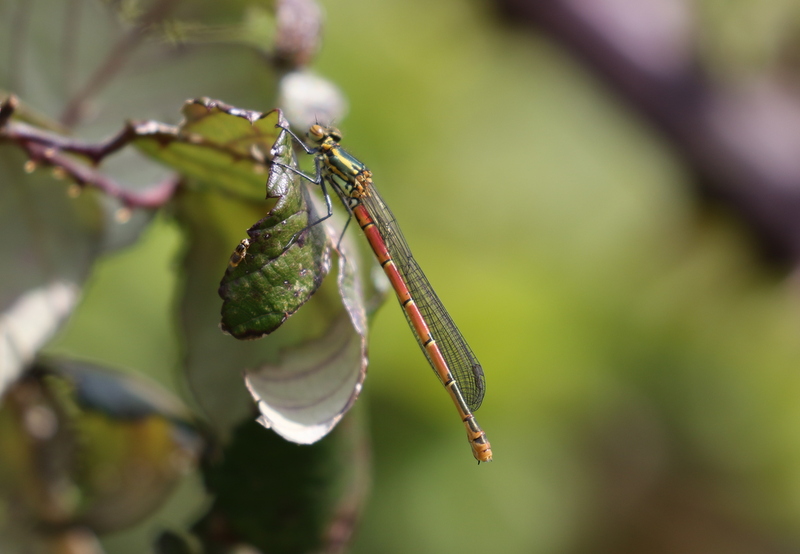 Large Red Damselfly – our first of the year
Large Red Damselfly – our first of the year
We made our way round to Holme for lunch. Afterwards, we had a quick walk around the paddocks. It was now the middle of the day so perhaps it was not a surprise we could not hear any sound from the Turtle Dove. There were lots of Common Whitethroats singing from the bushes.
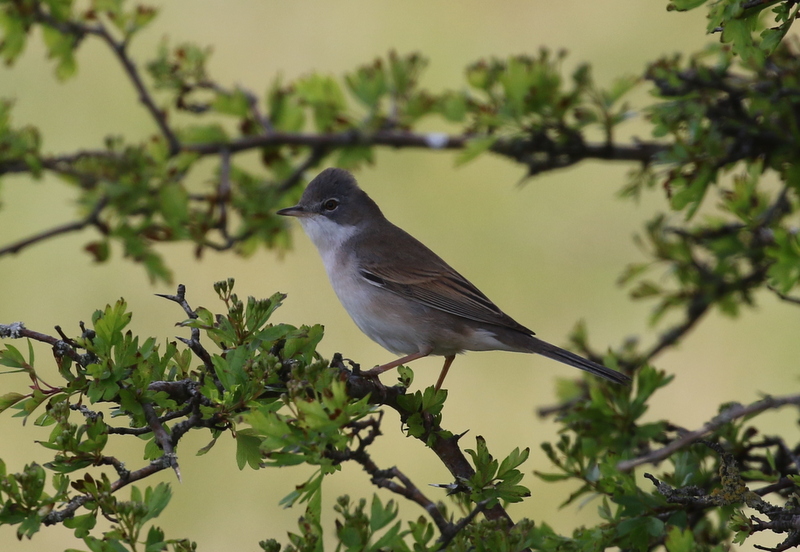 Common Whitethroat – singing in the bushes at Holme
Common Whitethroat – singing in the bushes at Holme
Out on the short grass on the edge of the dunes, a small orange butterfly which fluttered by was a Small Heath, also our first of the year. The warmer weather now is obviously finally bringing out more insects.
 Small Heath – out on the short grass on the edge of the dunes
Small Heath – out on the short grass on the edge of the dunes
We walked back along the road. A pair of Swallows were preening from the wires. A Mistle Thrush was out on the grass in the horse paddocks. There were lots of House Sparrows in the brambles.
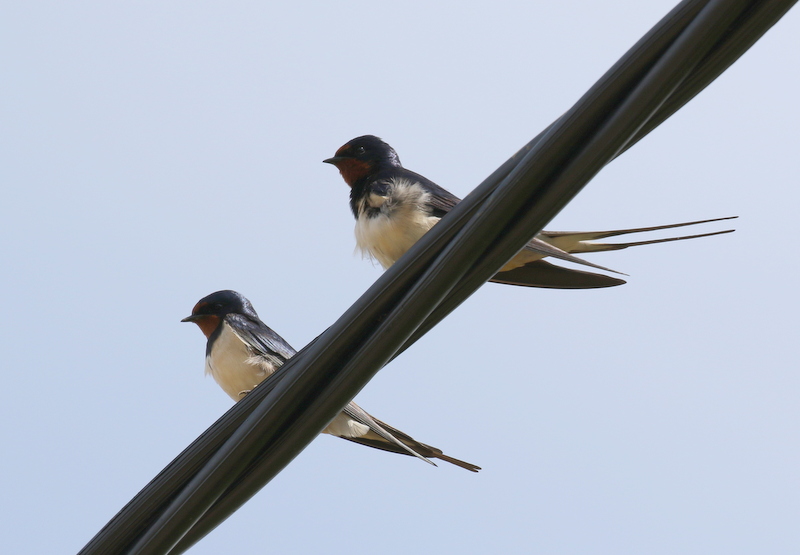 Swallows – on the wires over the road
Swallows – on the wires over the road
Our final destination for the day was Titchwell. There had been a little group of Wood Sandpipers on the grazing meadow ‘pool’ over high tide this morning, but unfortunately they had moved quickly on. We did manage to find a pair of Little Ringed Plovers, their golden yellow eye-rings shining in the sun. Further over, towards the back, were two Common Sandpipers around one the remaining pools.
The reedbed pool held a selection of diving ducks – three Red-crested Pochard including two males with bright orange punk haircuts and coral red bills, plus quite a few Common Pochard and a couple of Tufted Ducks. A pair of Little Grebes swam out of the reeds and down to the front.
We could hear lots of Sedge Warblers and Reed Warblers out in the reeds. Occasionally, a Cetti’s Warbler would shout at us from the brambles. However, the pinging of the Bearded Tits alerted us to their presence too, and we got good views of a female clambering around in the tops of the reeds. A male appeared, but promptly flew off in the direction of Fen Hide.
The water level on the Freshmarsh is still quite high and as a consequence there was nothing in front of Island Hide today. We continued straight along the main path. There were a couple of pairs of Common Terns on the nearest island to the path. From out at Parrinder Hide, there was a nice selection of ducks – Shoveler, several pairs of Teal, Gadwall and a few Shelduck.
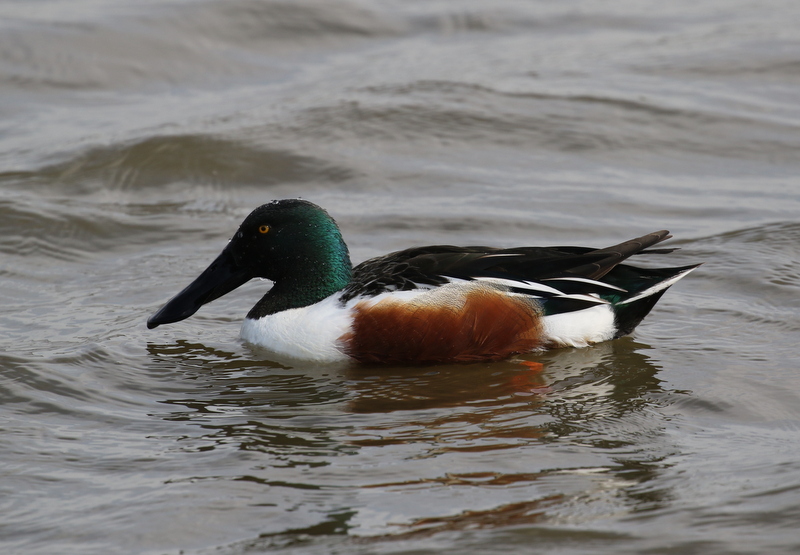 Shoveler – a pair were right in front of Parrinder Hide again
Shoveler – a pair were right in front of Parrinder Hide again
We had a more careful scan of the freshmarsh for waders from here. There were plenty of Avocets as usual. A single Black-tailed Godwit was preening out in the shallows. A Grey Plover appeared on one the nearer islands, still moulting into summer plumage, with patches of new black feathers below. Another Common Sandpiper appeared along the edge of the bank, just along from the hide, and a Little Ringed Plover was there as well.
There has been a single Little Stint here for several days now, and two were reported yesterday, but we were told when we arrived that they had not been seen today – yet! Checking methodically round the edges of some of the islands eventually produced the goods, with the two Little Stints together. They were inside the new Avocet fence at first, which meant it was not a great view. But after they flew off, they reappeared on the nearest island in front of the hide. Much better!
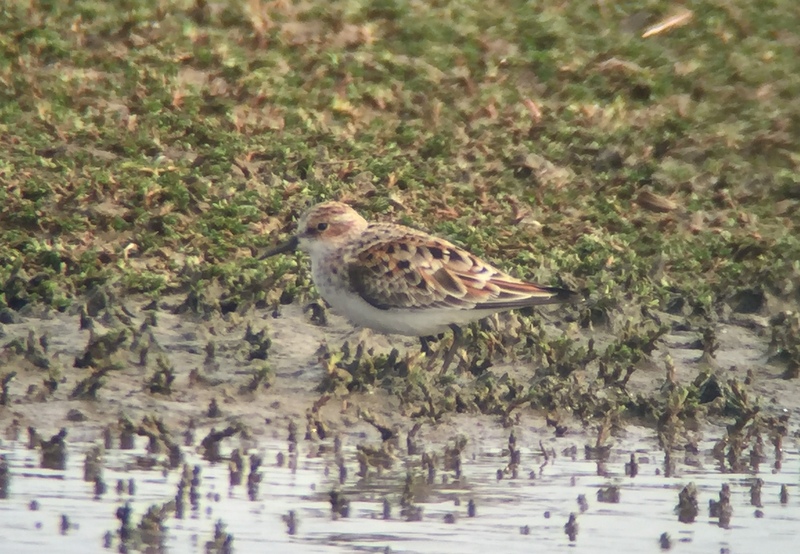
 Little Stints – we eventually found the two still on the Freshmarsh
Little Stints – we eventually found the two still on the Freshmarsh
The Little Stints are starting to get their summer plumage, with some brighter rusty fringed feathers appearing. When a couple of Avocets walked past, we could see just how tiny they are. Having enjoyed great views of them, we set off to walk out to the beach.
Another Avocet was feeding on the Volunteer Marsh, in the channel just below the main path, drawing some admiring glances and getting the cameras out as we went past.
 Avocet – the obligatory photo of this species from Titchwell
Avocet – the obligatory photo of this species from Titchwell
Otherwise, the Volunteer Marsh was rather devoid of life again until we got almost to the bank at the far end. A Whimbrel was feeding on the mud close by here.
 Whimbrel – feeding on the Volunteer Marsh
Whimbrel – feeding on the Volunteer Marsh
We had a quick look out on the beach. The tide was coming in fast, and the shellfish beds were completely covered. There were a lot of Sanderling along the shoreline today, more even than usual. They are probably stopping off on the their way north. Most of them are no longer in silvery-grey and white winter plumage, but are starting to get increasingly dark speckled or even rusty. Further over, towards Brancaster, we could see a high tide roost of Oystercatcher on the beach. As well as loads more Sanderling, a single Bar-tailed Godwit was with them.
The day was all but gone now, so we beat a retreat. On the way back, a quick look again at the Freshmarsh revealed that a couple of pairs of Little Tern had joined with the Common Terns. The Little Terns were mostly asleep, but did wake up regularly enough to be able to see their black-tipped orange bills. Then it was time to wrap up and head back to the car.
















